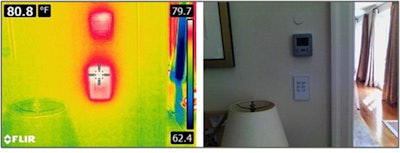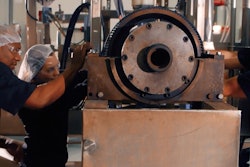
Professionals who install, inspect, and maintain heating, ventilation, air conditioning and refrigeration (HVAC/R) systems face a variety of challenges. In a single day, they might be part-electrician and work with electrical issues, be part-plumber and work with water or combustible gas related items traveling through pipework, or do both jobs and install an entire system. A thermal imaging camera can help HVAC/R professionals quickly determine the root cause of a problem, identify the faulty component and provide a level of trust that recommended repairs are indeed required.
Diagnosing Basic Efficiency Of Evaporating, Condensing And A/C Units
Residential HVAC technicians are usually called to sites with a very general complaint that “the system isn’t working,” only to find issues extending from basic component failures to problems with the condensing unit, evaporator coils and the air handling system.
Commercial and industrial HVAC techs usually work on regularly scheduled maintenance of these systems to maintain operational efficiency. Off-schedule visits are also needed to diagnose and repair a specific problem that may arise and limit plant operations. Customers want to avoid downtime and budget maintenance and repair expenses. They want to know well in advance if something is going to fail, since the cost of downtime can be very high. In addition, the cost of the repair may require approvals to proceed.
The method used to diagnose temperature related issues most frequently is a spot temperature gun, which is inexpensive and easy to use. Unfortunately, the device’s accuracy is entirely dependent on the user aiming it correctly. These devices don’t visually show the user where components are hot; instead, the user has to guess where the problem may lie, and aim the sensor at that component to measure its temperature.
HVAC technicians have recently started to use thermal imaging cameras to find problem areas in all areas of their work. These cameras work by detecting heat (or lack of heat) given off by an object. The sensor takes the energy and translates it into light. The viewer sees the light in a range of colors: red, orange and yellow indicates heat, while dark blue, black or purple signifies colder temperature.
Thermal imaging is valuable for the pure speed of which it can diagnose basic HVAC problems. Thermal imaging is a great tool for finding problems with fuses, breakers, connections, belts, bearings and hoses. It also helps see differential temperatures and find problems with the building construction that might have an impact on system performance. Whether the problem is a failing unit or one that is operating inefficiently, a thermal imaging camera can clearly show if a component is clogged or not working properly.

Similarly, a thermal imaging camera can be used to detect if the evaporating units are working up to par. For example, if the evaporator coil tubes are clogged, the camera can detect if the flow is uniform, or whether only half the coil is working properly.
An HVAC contractor can also diagnose issues associated with air conditioner units running inside a building. Using a thermal imaging camera, technicians can quickly scan every vent and register to see if the temperatures are uniform, or if any spots are too warm or too cold.
Thermal imaging also makes it easier to conduct troubleshooting activities, especially with the electrical side of HVAC/R systems. Thermal imaging will guide a technician to electrical components that may not be operating properly, whether they are overloaded or not operating at all. All operating circuits show some sort of heat during operations, but when several circuits look uniform, and one reads hotter or colder than the surrounding comparable items, it may be worth investigating.
Thermal Imaging Adds Credibility And Creates A Higher Level Of Trust With Consumers
Another essential feature of thermal imaging is that it can be used to document existing issues. Showing images to customers can help support technicians’ recommendations for additional work that may be needed. Additionally, images may be collected over time and used to look at the long-term “health” of a component, or establish operational norms of properly operating equipment and trend analysis.
Air leaks are clearly visible with thermal imaging. The cause may be old ductwork, leaky ductwork, improper insulation or connections between components, or faulty operation of components. These items are generally invisible without thermal imaging. A technician who shows the customer the problem visually to secure the work, fixes the issue, and follows up with a before/after image will be much more credible. Some HVAC technicians even insert a before and after picture on their invoice to provide assurance that the issue was corrected as diagnosed. Happy customers – who are confident in the work process – are customers who lead to referrals and repeat business.

Real World Examples Of Using Thermal Imaging To Solve A Problem
At a senior center in Idaho, facility managers could not explain a huge increase in energy costs over a nine to twelve month period. Power bills had risen
from $300 to $900 dollars per month even though energy prices had not increased significantly and they had recently installed a new high-efficiency HVAC system.
The FLIR team met with the head manager and his technicians and provided each with a FLIR E6 thermal imaging camera to start looking for problems. The E6 is the best balance of cost, resolution and temperature sensitivity. Dramatic thermal images clearly reveal problems, from sources of energy loss and structural issues to overheating electrical and mechanical equipment.
The team looked at exterior walls to check for missing insulation and checked doors and windows for air leaks.
The surprise came when one of the technicians pointed the camera up at the ceiling, asking why the furnace was on in July. The facilities manager said that was impossible, but after checking the thermostat, he found that indeed the furnace was running alongside the air conditioner! The HVAC contractor who installed the new system had made a simple wiring mistake, and the facility was running the A/C and furnace at the same time throughout that winter and summer.
Had the HVAC contractor used a thermal camera, he could have turned the system on and immediately caught his wiring mistake. Within five minutes, the team had solved an avoidable problem that had formerly cost a good deal of money and time trying to figure out.
Another example is a residential customer who complained of overheating in an area with radiant heating. The customer was convinced faulty installation of the radiant zone was causing the problem. As fast as they turned on the E6 camera and aimed it at the floor, technicians clearly saw the problem was not the radiant heat. Instead, it was caused by another heat source: un-insulated hot water lines. The easy fix was getting the plumber to insulate his lines. In this case, the old expression “a picture is worth a thousand words” rang true.
On the flip side, another customer complained that it was too cold by a doorway and the radiant heat was either not working or not properly installed. The images taken with the FLIR E6 showed the radiant was working well, and installed correctly, as close to the door as possible. No fix was needed, since the photo showed the radiant manifold working correctly.
Another interesting example is a customer who complained that the garage was excessively hot in the warmer months and blamed the radiant system. Thermal images taken with the FLIR E6 quickly proved that the radiant system was not the root of the problem. Rather, the problem resulted from two co-generation inverters that were blowing out 120° F air directly into the garage. An electrician was called in to relocate the inverters to a location with proper ventilation.

A final example comes from a customer who complained that the thermostat was out of calibration because the room felt colder than the thermostat reading. Using the FLIR E6 helped show that a light switch was the real problem, the thermostat was reading the correct temperature radiated by a light switch below. The customer saved money by relocating the thermostat instead of replacing a unit that was not faulty.
Thermal Imaging Cameras Pay For Themselves Within A Matter Of Days
When technicians can find (and display) an issue in minutes versus an hour of diagnostic testing, they can do the job faster and make more calls per day. At the same time they can use the thermal imaging tool to create a higher level of trust and prove to the customer’s satisfaction that the work recommended is necessary. HVAC contractors who use a thermal imaging camera will pay for the tool in as little as one to three days. Unlike many tools in a technician’s bag, thermal imaging cameras generate revenue by finding issues faster, verifying a job well done and creating life-long customer loyalty.























